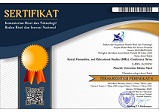Dampak Positif dan Negatif Penggunaan Uang Elektronik di Dunia Pendidikan
Abstract
This research aims to explore the use of electronic money in the world of education, as well as its positive and negative impacts. This research is a literature study from various studies discussing the use of electronic money in education. Data was retrieved via Google Scholar on the Publish or Perish (PoP) software. The search was carried out using the keywords "education" and the title "electronic money," and from 2019 to 2023, sourced from national journals. The 14 pieces of literature were then analyzed qualitatively, including the stages of codification, thematic grouping, and interpretation with the help of NVivo software, widely used in qualitative research. Based on a study of 14 pieces of literature, electronic money in the educational realm can be divided into two levels: the school and the tertiary. Digital money at each level certainly has goals, focus, and similar priorities, such as use for paying tuition fees or UKT. Based on the results of the study, there are also advantages and disadvantages of using electronic money. The advantages are ease of use and monitoring of transactions, while the disadvantages are security, consumptive factors, and decreased interaction. Furthermore, some disadvantages of using electronic money are security, waste, and decreased interaction.
Keywords
Full Text:
PDFRefbacks
- There are currently no refbacks.





